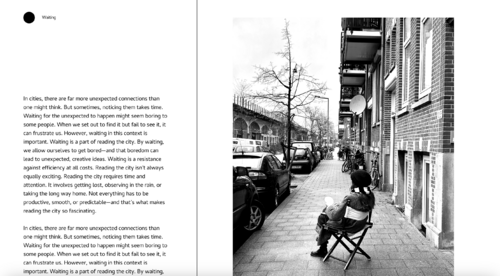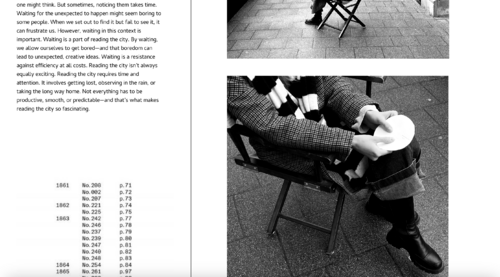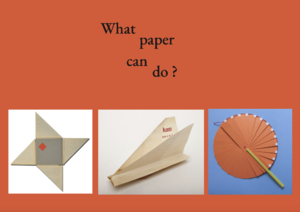User:Mania/Assesment
Project proposal
What do you want to make?
Fragments is a magazine that is created for reading our cities. I seek ways to open to different experiences, searching for unpredictability and surprises in the city, exciting connections, and interactions with others. This magazine may seem a bit messy, but this messiness in unpredictability can bring unexpected connections. And this is what the act of making this magazine public and publishing it outdoors call for. It seeks to decode the language of the city and by actively existing in public space, it becomes a tool for that, knowing that this act is an unfinished process. The image of the city is ever changing, its never complete.
Fragments is a way to support performative interactions with space
Fragments is a tool to find diffrent ways to navigate our cities
Fragments is an invitation to looking with with curious eyes
Fragments is a search for unpredictability and surprises in the city
Fragments is a place for interactions with others in shared space
Fragments is published intermittently and meant to be read outside
How do you plan to make it?
The first issue dedicated for:
PEOPLE who always carry a notebook
TO SEE the choices in how we move
IN open spaces
Systems to energize exploration in physical space
I became intrested in scores, graphical notations. Scores constitute a system of symbols where elements like time, space, rhythm, and their combinations are presented graphically, visualising a process over time and influencing it. Scores allow for the process to constantly evolve.
I’m curious about translating what film works with into a system for exploring physical space.
Film deals with: frames scripts continuity speed time rhythm...
I’m curious to use these elements as tools for decoding the language of the city.
- Framing
How can movement be visualized and influenced in a graphical form? There is a difference between graphical representation and the action that results from it. But one informs the other.
A zoetrope moves individual frames, animating them into smooth motion. But when I look at it as a flat image, it becomes a graphic representation of that movement over time. It reminds me of musical notation. What if I were to record movement using symbols, similar to a musical staff? Instead of a composition, I could record a walk…
The zoetrope, by animating frames arranged in a circle, plays with continuity and repetition. Similarly, I could write notes on a staff that loops into a circle, suggesting that this segment should be played repeatedly, over and over. By playing with this looping, we could create a notation for a walking choreography where you continually turn only to the right, or only take narrow streets. Frames, continuity, repetition.
2. Playing with speed, time, sequence
walk with a chair
Why do you want to make it?
After completing the Scripts to Read the City project, I find the question of what perspectives artistic research can bring to urban spaces very relevant. I love cities and I am interested in projects rooted in this context.
Design for situations, for friction…René Boer’s concept of the “Smooth City” ties into this idea. He describes the growing tendency in urban environments where experiences become increasingly seamless. We have services that deliver groceries to our doors, dating apps, and smart solutions that provide us with comfort, but they also create a frictionless environment. While everyone deserves a safe and clean environment, such conditions gradually eliminate opportunities for serendipity, potential, encounters, and all those unexpected events that cannot be planned in advance. This raises an important question: what kind of cities do we really want? Do we prefer a predictable, frictionless environment, or do we want to embrace random chances? Personally, I long for a city where I can be myself, where I enjoy conversations with strangers, where I discover new paths, where not everything is reduced to the same ideal, polished appearance—a city created by people and therefore full of potential.
So with this work I seek ways to open to different experiences, searching for unpredictability and surprises in the city, exciting connections, and interactions with others in shared spaces. Working with system very much open for interpretation it just energize stepping outside, observing and moving through spaces with renewed intrest.
Between an object and the event
- I’m planning to organise a workshop in De Boog to make a publication that doesnt just depict the surroundings how I see them but engages readers in experiencing and reinterprating them.
- Colloquium - as an oppurtnity to test paper based tools.
A TOOL
FOR people who get lost in their thoughts
TO SEE the absurdity
IN open space
A TOOL
FOR people always in a hurry
TO SEE the stories in gestures
IN the shadowed corners
A TOOL
FOR people who love surprises
TO SEE the endless possibilities
IN an open park at night
A TOOL
FOR people always in a hurry
TO SEE the city as a game
IN the spaces in between
A TOOL
FOR people who always carry a notebook
TO SEE with the greatest precision
IN an open park at night
A TOOL
FOR people who speak with their hands
TO SEE the stories
IN every turn they take
A TOOL
FOR people who miss their hometown
TO SEE the absurdity
IN open space
Relation to previous practice
Fragments Magazine will build upon the experience gained in previous semesters. Starting with the research into neighborhoods as learning environments, which I began in the second semester and drawing heavily from the last Special Issue. Fragments Magazine continues the exploration of the theme undertaken during the Scripts to Read the City project, where I tried to create a series of scripts that encourage spontaneous behavior and exploration of space. The result of the work was a device for reading the city and a guide containing scripts that encourage the discovery of opportunities we might encounter and the viewing of the city from someone else’s perspective. Additionally, as part of the project we conducted a series of workshops in which participants wrote their own scripts, and then we walked around the city according to a script written by someone else.
For the magazine I utilize the exploration of the relationship between scripted and spontaneous behaviour, the tension between chance and control, and how the simple tool or a script can enhance unpredictability, stimulate imagination and encourage us to observe space with curiosity, as if we were looking from someone else's perspective. Treating this as a foundation, I want to experiment more with printed matter, forming scripts and playing with the physicality of paper, to understand how a magazine can shape the way we perceive our surroundings. This project studies how even the simplest tools, which impose certain limitations, can open us to unexpected opportunities and seeing our surroundings in a new way. It considers magazines as shared resources that help us observe, see differently, and encourage us to question reality. I want to explore the role that self-publishing and distribution might play in this context, by thinking about ways I’ll publish my project to create networks of exchange.
This summer, I attended a summer school focused on urban space as a place for various (un)learning practices, activating different modes of knowing, sensing, and being/becoming together. I met people from urban studies, researchers, and other artists interested in participatory urban interventions, and I think that these connections could also help me now, by providing constructive conversations.
What is your time table?
BLOCK 1
September, October, November
Content
- Participating in Zine festivals, leading workshop in Groningen
- Experiments with camera obscura, paper frames, photographs and collages
- Public moment
- Finalizing project proposal and research outline
- Coloqium - testing workshop format 1
- Experiment with the formats of the magazine to exist outside
- Prepare the schedule
- Research into existing magazines before I start designing
- The question what I focus on (is it image heavy, repository of tool, do I include cultural context in a written form?)
BLOCK 2December, January, February
Content
- Assesment
- workshop 2 - De Boog
- workshop 3
Design draft
- idea for possible formats to actively exist outdoors
- practice practice practice web (template tool to print?)
BLOCK 3March, April, May
Design
- Overview of the content (break everything to see what comes page by page )
- How to print cost-effectively and how to get the most out of my format
- Material
Production
- printing
- binding
- fixing
FINAL MONTHJune
Distribution
- Activation in public space
- Documentation
- Celebration
Who can help you and how?
I can definitely count on the people from De Boog—they’re also interested in print and always look for ways to do things together. I’m planning to run a workshop there, and their help will be very valuable.
Manetta - with concept and methods and web to print
Joseph - with questions regarding website
Steve - with guidence and valuable references
Some emotional support from other students and friends.
References:
Johanathan Crary, Techniques of the Observer
Lorraine Daston and Peter Galison Objectivity, MIT, (2007)
Georges Perec, Species of Spaces and Other Pieces
Guy Debord, Report on the Construction of Situations(1957)
The Situationist International (SI) - Situationist maps, like The Naked City (1957), fragment Paris into emotional zones, challenging the conventional ways cities are navigated and understood.
Soda Kazhiro, Why I Make Documentaries, on Observational Filmmaking
Kevin Lynch, The Image of the City
Italo Calvino, Invisible Cities
Rebecca Solnit, Infinite City: A San Francisco Atlas (2010)
Jane Jacobs , The Death and Life of Great American Cities (1961) - Jacobs emphasized the importance of "eyes on the street" and mixed-use urban areas, critiquing large-scale modernist urban planning in favor of organic, community-oriented design.
Dziga Vertov – Man with a Movie Camera (1929)
Agnes Varda – Daguerreotypes (1976)
Frederick Wiseman – In Jackson Heights (2015)






















